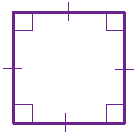Lesson 1
Quadrilaterals
The one simple thing you need to know to identify quadrilaterals is that they are polygons with FOUR sides. Simply, quadrilaterals are 4-sided polygon.
Quad – meaning four
Lateral – meaning sides
Since it is a polygon, you know that it is a two-dimensional figure made up of straight sides. A quadrilateral also has four angles formed by its four sides.
Specific Types of Quadrilaterals
Trapezoids
Unlike parallelograms, trapezoids have only one set of parallel lines. The other two sides have no restrictions. A trapezoid is a quadrilateral with exactly one pair of parallel sides.

Kite
- Two pairs of sides are of equal length.
- One pair of diagonally opposite angles is equal.
- Only one diagonal is bisected by the other.
- The diagonals cross at 90°. (Diagonals are perpendicular)

Parallelograms
A 4-sided flat shape with straight sides where opposite sides are parallel. Also: opposite sides are equal in length, and opposite angles are equal
Specific examples of Parallelograms
Rectangle

A rectangle is a parallelogram because its pairs of opposite sides are parallel. A rectangle’s angles are all right angles (90 degrees). All of the 4 angles are congruent.

Rhombus
Another type of parallelogram is a rhombus. All four sides of a rhombus are equal or congruent.
It is a parallelogram with opposite equal acute angles, opposite equal obtuse angles, and four equal sides.
Square

Squares are both rhombuses and rectangles. Meaning they have the characteristic of both: 4 equal sides and 4 right angles.
All squares are rectangles but not all rectangles are squares. All squares are rhombuses but not rhombuses are squares. All rectangles are parallelograms, but not all parallelograms are rectangles. And all of these shapes are quadrilaterals.
The diagram illustrates the relationship of parallelograms


